Torque-Pulse-Based Initial Rotor Polarity Detection for IPMSM with Low Saturation Effect
Abstract
:1. Introduction
2. High Frequency Injection and Saturation-Based Rotor Polarity Detection
2.1. High Frequency Injection
2.2. Rotor Polarity Detection Based on Saturation Effect
3. Rotor Polarity Detection Based on Torque-Pulse Injection
4. Procedure of Initial Rotor Position Estimation
5. Experimental Verification
5.1. Saturation Effect of the IPMSM Studied in this Paper
5.2. Test Bench Introduction
5.3. Initial Rotor Position Estimation with No Load
5.3.1. The Proposed Method with Current-Observer-Based Current Filter
5.3.2. Comparison with Method Using Conventional Subtraction-Based Current Filter
5.4. Initial Rotor Position Estimation with Inertia Load
5.5. Initial Rotor Position Estimation with Inertia-Friction Load
5.6. Comparison with the Saturation-Based Method
6. Conclusions
Author Contributions
Funding
Data Availability Statement
Conflicts of Interest
Nomenclature
| Fundamental voltage command vector in axis | |
| Injected high-frequency rotating voltage vector in axis | |
| Measured total current vector in axis | |
| Fundamental current vector in axis | |
| High-frequency current vector in axis | |
| High-frequency negative-sequence current vector in axis | |
| Fundamental current vector in axis | |
| Real electrical rotor speed | |
| Real electrical rotor position | |
| Estimated electrical rotor speed | |
| Estimated electrical rotor position | |
| Stator inductance (d and q axes, respectively) | |
| Fundamental current command (d and q axes, respectively) | |
| Electrical rotor position command |
References
- Wang, G.; Valla, M.; Solsona, J. Position Sensorless Permanent Magnet Synchronous Machine Drives—A Review. IEEE Trans. Ind. Electron. 2020, 67, 5830–5842. [Google Scholar] [CrossRef]
- Xiao, D.; Nalakath, S.; Filho, S.R.; Fang, G.; Dong, A.; Sun, Y.; Wiseman, J.; Emadi, A. Universal Full-Speed Sensorless Control Scheme for Interior Permanent Magnet Synchronous Motors. IEEE Trans. Power Electron. 2021, 36, 4723–4737. [Google Scholar] [CrossRef]
- Raca, D.; Garcia, P.; Reigosa, D.D.; Briz, F.; Lorenz, R.D. Carrier-signal selection for sensorless control of pm synchronous machines at zero and very low speeds. IEEE Trans. Ind. Appl. 2010, 46, 167–178. [Google Scholar] [CrossRef]
- Benjak, O.; Gerling, D. Review of position estimation methods for pmsm drives without a position sensor, part iii: Methods based on saliency and signal injection. In Proceedings of the 2010 International Conference on Electrical Machines and Systems (ICEMS), Incheon, Republic of Korea, 10–13 October 2010; pp. 873–878. [Google Scholar]
- Bojoi, R.; Pastorelli, M.; Bottomley, J.; Giangrande, P.; Gerada, C. Sensorless control of pm motor drives—A technology status review. In Proceedings of the 2013 IEEE Workshop on Electrical Machines Design, Control and Diagnosis (WEMDCD), Paris, France, 11–12 March 2013; pp. 168–182. [Google Scholar]
- Zhu, Z.Q.; Gong, L.M. Investigation of effectiveness of sensorless operation in carrier-signal-injection-based sensorless-control methods. IEEE Trans. Ind. Electron. 2011, 58, 3431–3439. [Google Scholar] [CrossRef]
- Holtz, J. Acquisition of position error and magnet polarity for sensorless control of pm synchronous machines. IEEE Trans. Ind. Appl. 2008, 44, 1172–1180. [Google Scholar] [CrossRef]
- Wang, G.; Qu, L.; Zhan, H.; Xu, J.; Ding, L.; Zhang, G.; Xu, D. Self-commissioning of permanent magnet synchronous machine drives at standstill considering inverter nonlinearities. IEEE Trans. Power Electron. 2014, 29, 6615–6627. [Google Scholar] [CrossRef]
- Wu, X.; Feng, Y.; Liu, X.; Huang, S.; Yuan, X.; Gao, J.; Zheng, J. Initial rotor position detection for sensorless interior pmsm with square-wave voltage injection. IEEE Trans. Magn. 2017, 53, 1–4. [Google Scholar] [CrossRef]
- Wang, Z.; Cao, Z.; He, Z. Improved fast method of initial rotor position estimation for interior permanent magnet synchronous motor by symmetric pulse voltage injection. IEEE Access 2020, 8, 59998–60007. [Google Scholar] [CrossRef]
- Shuang, B.; Zhu, Z.-Q. A novel sensorless initial position estimation and startup method. IEEE Trans. Ind. Electron. 2021, 68, 2964–2975. [Google Scholar] [CrossRef]
- Raca, D.; Harke, M.C.; Lorenz, R.D. Robust magnet polarity estimation for initialization of pm synchronous machines with near-zero saliency. IEEE Trans. Ind. Appl. 2008, 44, 1199–1209. [Google Scholar] [CrossRef]
- Xu, P.; Zhu, Z.Q. Initial rotor position estimation using zero-sequence carrier voltage for permanent-magnet synchronous machines. IEEE Trans. Ind. Electron. 2017, 64, 149–158. [Google Scholar] [CrossRef]
- Liu, B.; Zhou, B.; Wei, J.; Wang, L.; Ni, T. A novel method for polarity detection of nonsalient pmsms in initial position estimation. In Proceedings of the 2016 IEEE Applied Power Electronics Conference and Exposition (APEC), Long Beach, CA, USA, 20–24 March 2016; pp. 2754–2758. [Google Scholar]
- Gong, L.M.; Zhu, Z.Q. Robust initial rotor position estimation of permanent-magnet brushless ac machines with carrier-signal-injection-based sensorless control. IEEE Trans. Ind. Appl. 2013, 49, 2602–2609. [Google Scholar] [CrossRef]
- Zhang, X.; Li, H.; Yang, S.; Ma, M. Improved initial rotor position estimation for pmsm drives based on hf pulsating voltage signal injection. IEEE Trans. Ind. Electron. 2018, 65, 4702–4713. [Google Scholar] [CrossRef]
- Wu, T.; Luo, D.; Huang, S.; Wu, X.; Liu, K.; Lu, K.; Peng, X. A fast estimation of initial rotor position for low-speed free-running ipmsm. IEEE Trans. Power Electron. 2020, 35, 7664–7673. [Google Scholar] [CrossRef]
- Zhao, C.; Tanaskovic, M.; Percacci, F.; Mariethoz, S.; Gnos, P. Sensorless position estimation for slotless surface mounted permanent magnet synchronous motors in full speed range. IEEE Trans. Power Electron. 2019, 34, 11566–11579. [Google Scholar] [CrossRef]
- Tanaskovic, M.; Zhao, C.; Percacci, F.; Gnos, P.; Mariethoz, S.; Frick, D. Rotor polarity detection and tracking for slotless permanent magnet synchronous motors. In Proceedings of the 2018 IEEE 9th International Symposium on Sensorless Control for Electrical Drives (SLED), Helsinki, Finland, 13–14 September 2018; pp. 102–107. [Google Scholar]
- Sun, W.; Shen, J.; Jin, M.; Hao, H. A robust magnetic polarity self-sensing method for start up of pm synchronous machine in fanlike system. IEEE Trans. Ind. Appl. 2017, 53, 2169–2177. [Google Scholar] [CrossRef]
- Briz, F.; Diez, A.; Degner, M.W. Dynamic operation of carrier-signal-injection-based sensorless direct field-oriented ac drives. IEEE Trans. Ind. Appl. 2000, 36, 1360–1368. [Google Scholar] [CrossRef]
- Illindala, M.; Venkataramanan, G. Frequency/sequence selective filters for power quality improvement in a microgrid. IEEE Trans. Smart Grid 2012, 3, 2039–2047. [Google Scholar] [CrossRef]
- Briz, F.; Degner, M.W.; Diez, A.; Lorenz, R.D. Measuring, modeling, and decoupling of saturation-induced saliencies in carrier-signal injection-based sensorless ac drives. IEEE Trans. Ind. Appl. 2001, 37, 1356–1364. [Google Scholar] [CrossRef] [Green Version]
- Degner, M.W.; Lorenz, R.D. Using multiple saliencies for the estimation of flux, position, and velocity in ac machines. IEEE Trans. Ind. Appl. 1998, 34, 1097–1104. [Google Scholar] [CrossRef]
- Vadstrup, P.; Lorenz, R.D. Robust estimator design for signal injection-based ipm synchronous machine drives. In Proceedings of the Conference Record of the 2004 IEEE Industry Applications Conference, 2004. 39th IAS Annual Meeting, Seattle, WA, USA, 3–7 October 2004; Volume 2, pp. 957–963. [Google Scholar]
- Gong, L.M.; Zhu, Z.Q. A novel method for compensating inverter nonlinearity effects in carrier signal injection-based sensorless control from positive-sequence carrier current distortion. IEEE Trans. Ind. Appl. 2011, 47, 1283–1292. [Google Scholar] [CrossRef]
- Secrest, C.W.; Ochs, D.S.; Gagas, B.S. Deriving state block diagrams that correctly model hand-code implementation-correcting the enhanced luenberger style motion observer as an example. IEEE Trans. Ind. Appl. 2020, 56, 826–836. [Google Scholar]
- Dajaku, G.; Xie, W.; Gerling, D. Reduction of low space harmonics for the fractional slot concentrated windings using a novel stator design. IEEE Trans. Magn. 2014, 50, 1–12. [Google Scholar] [CrossRef]

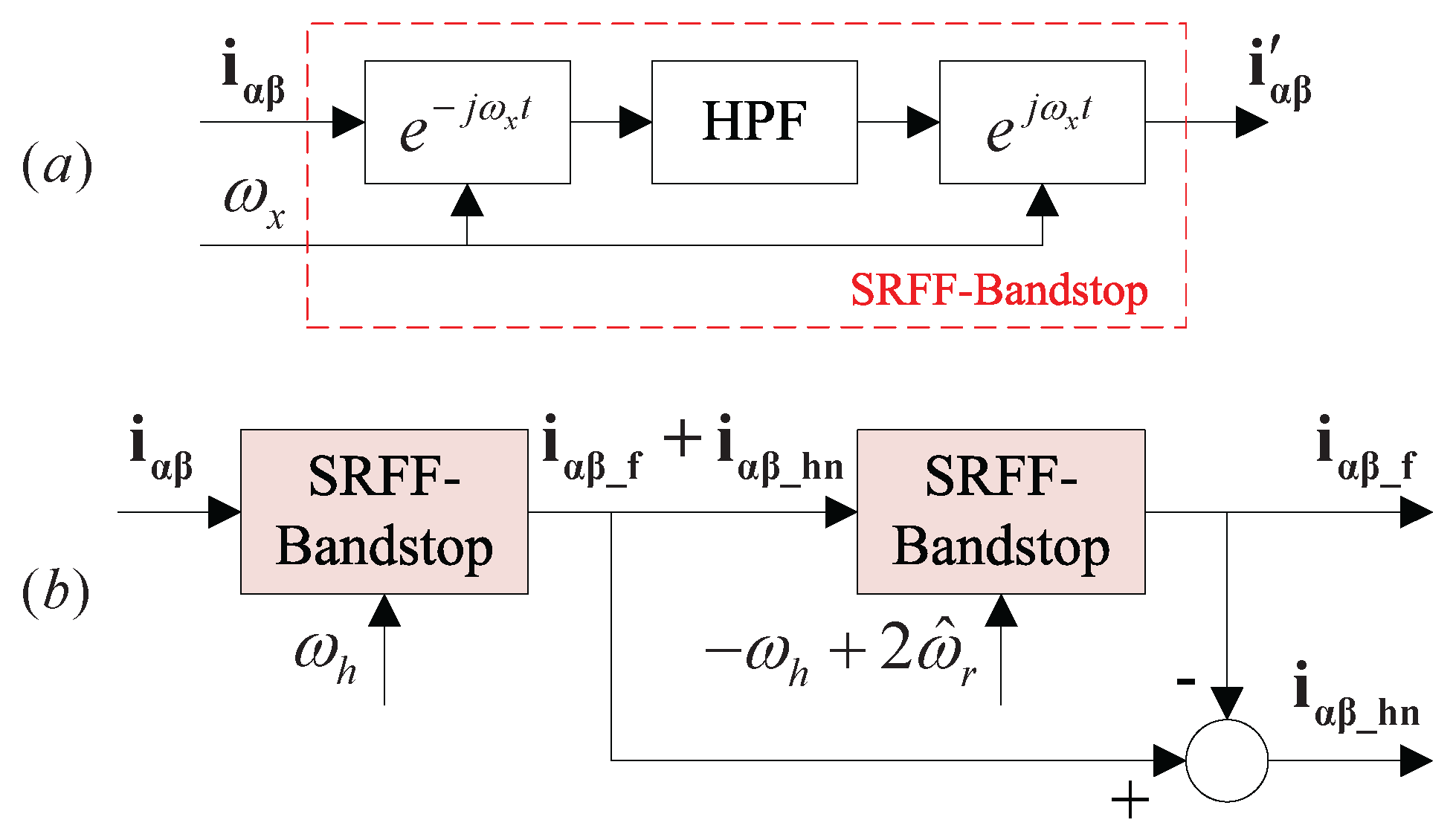

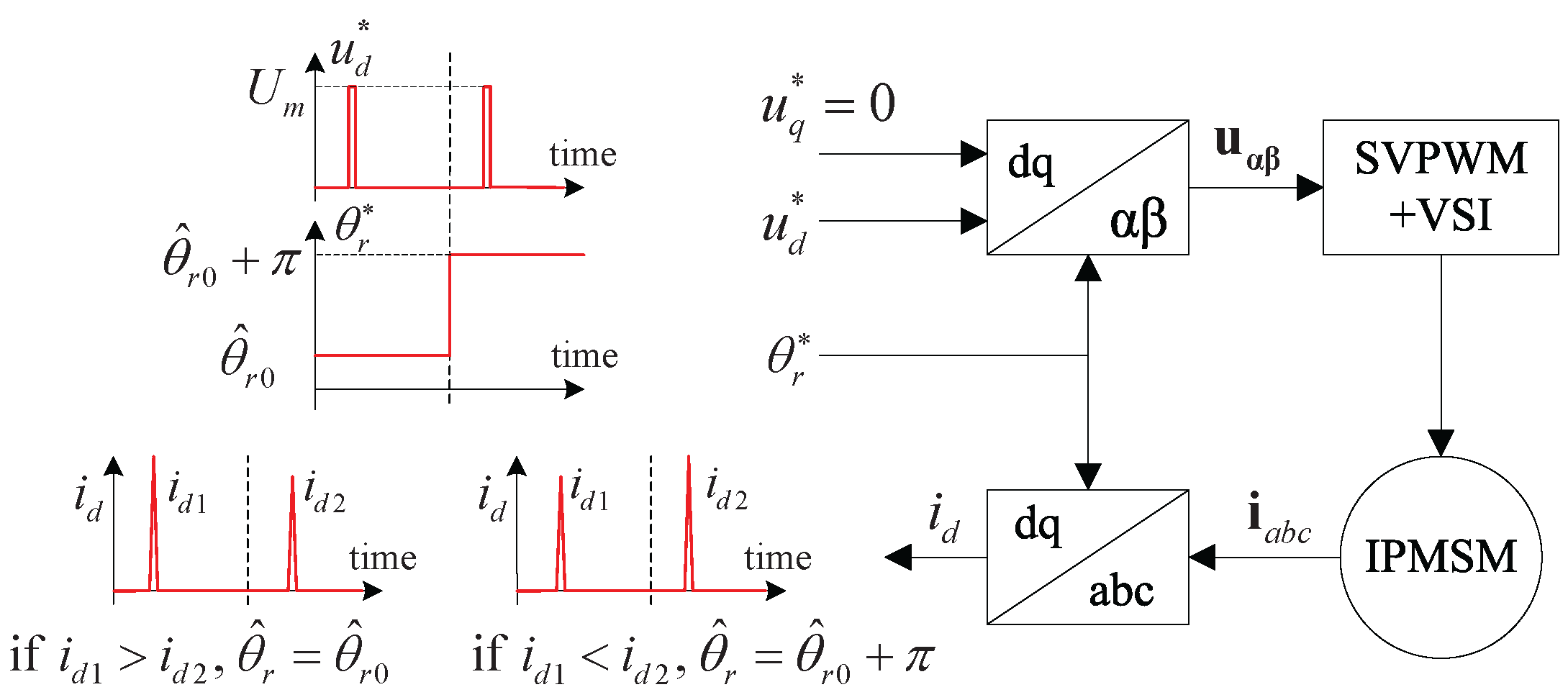


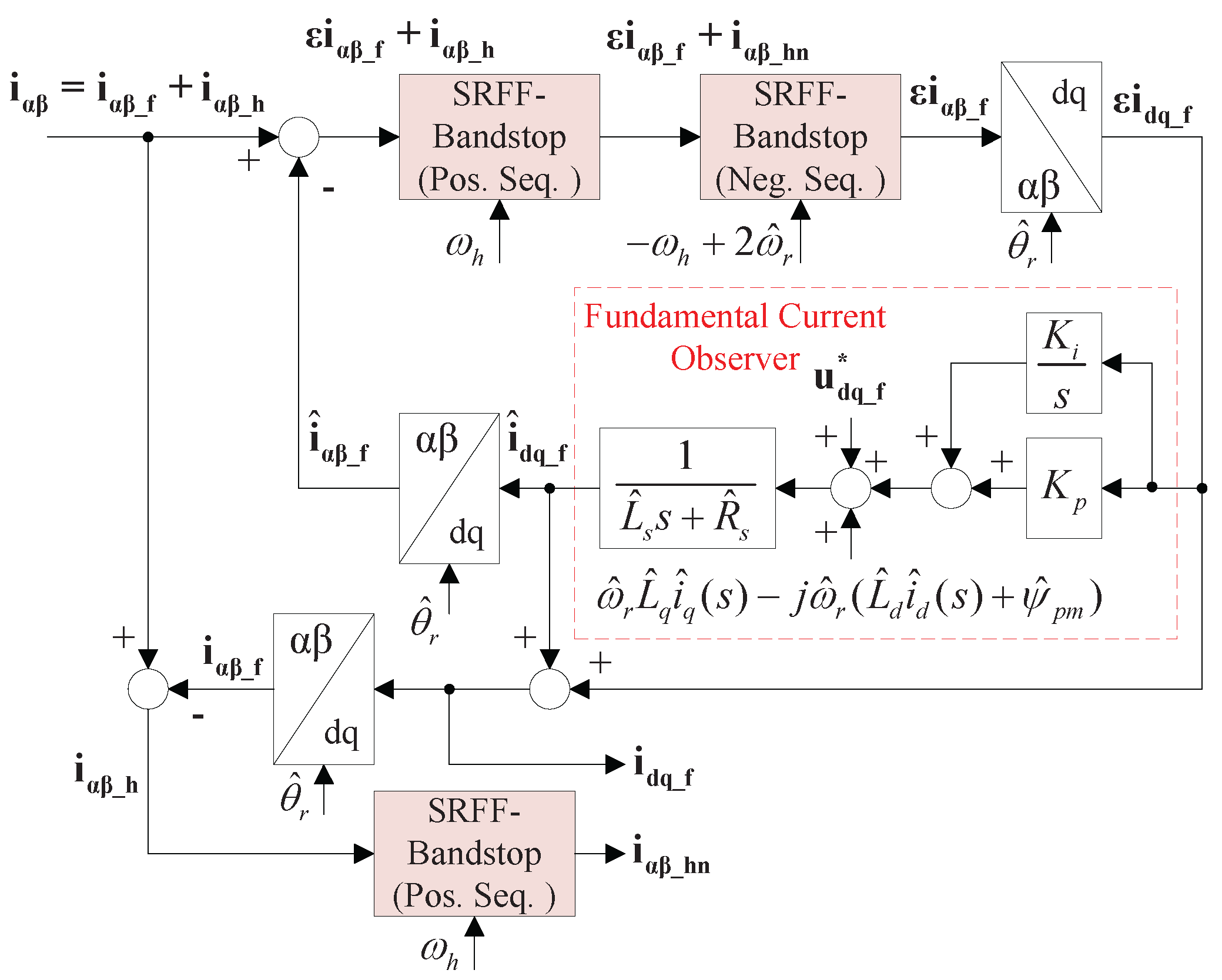

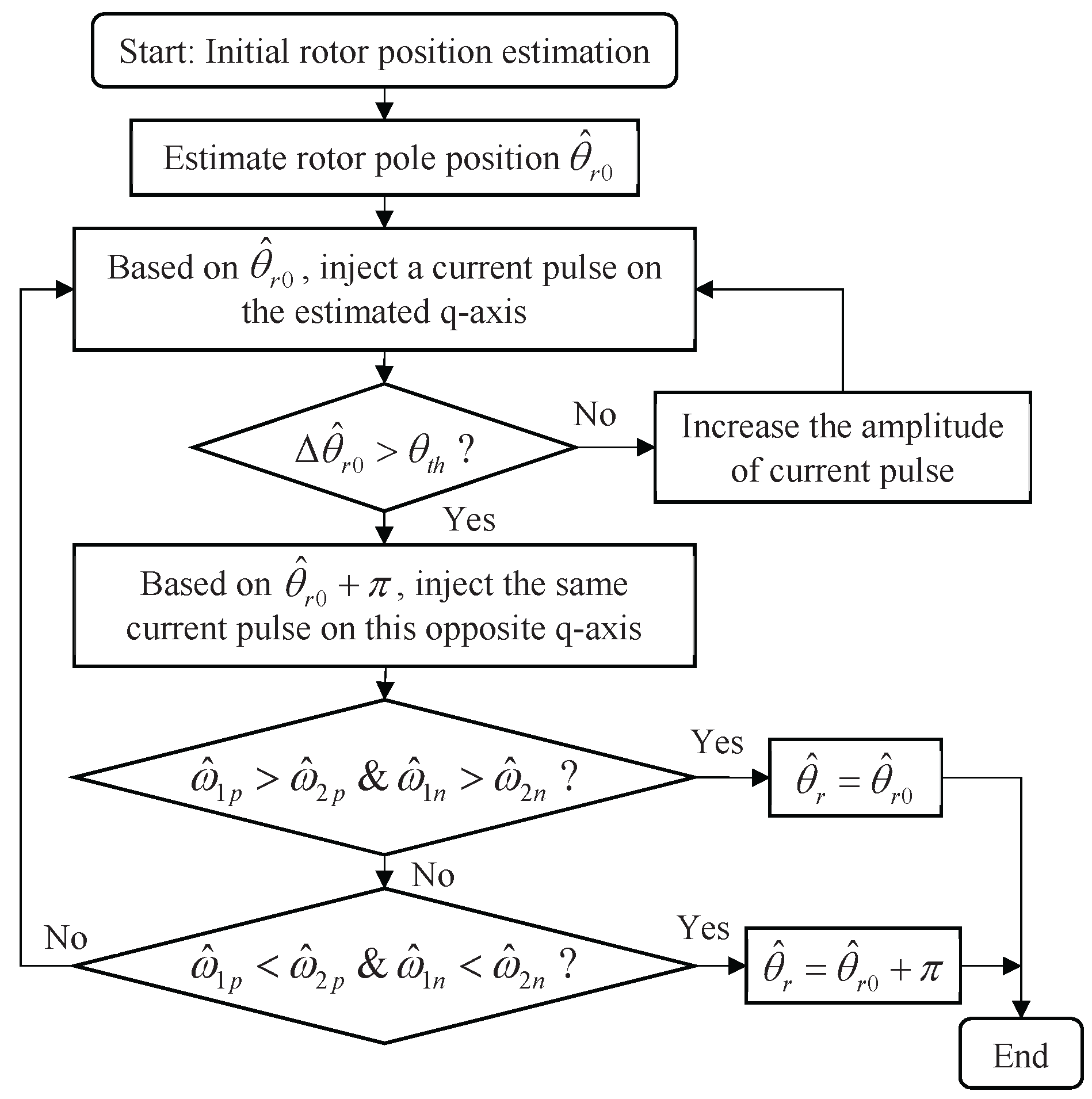


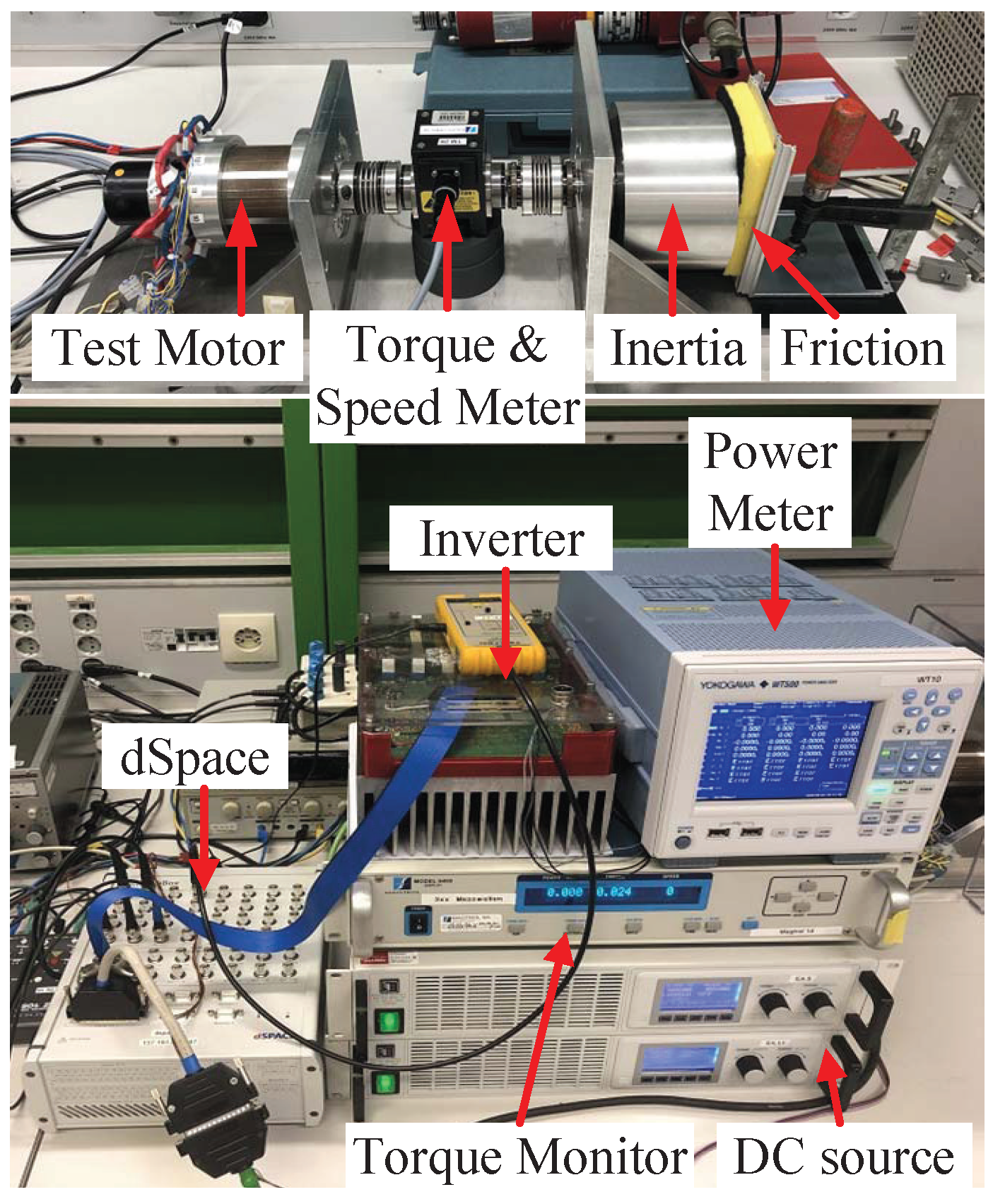
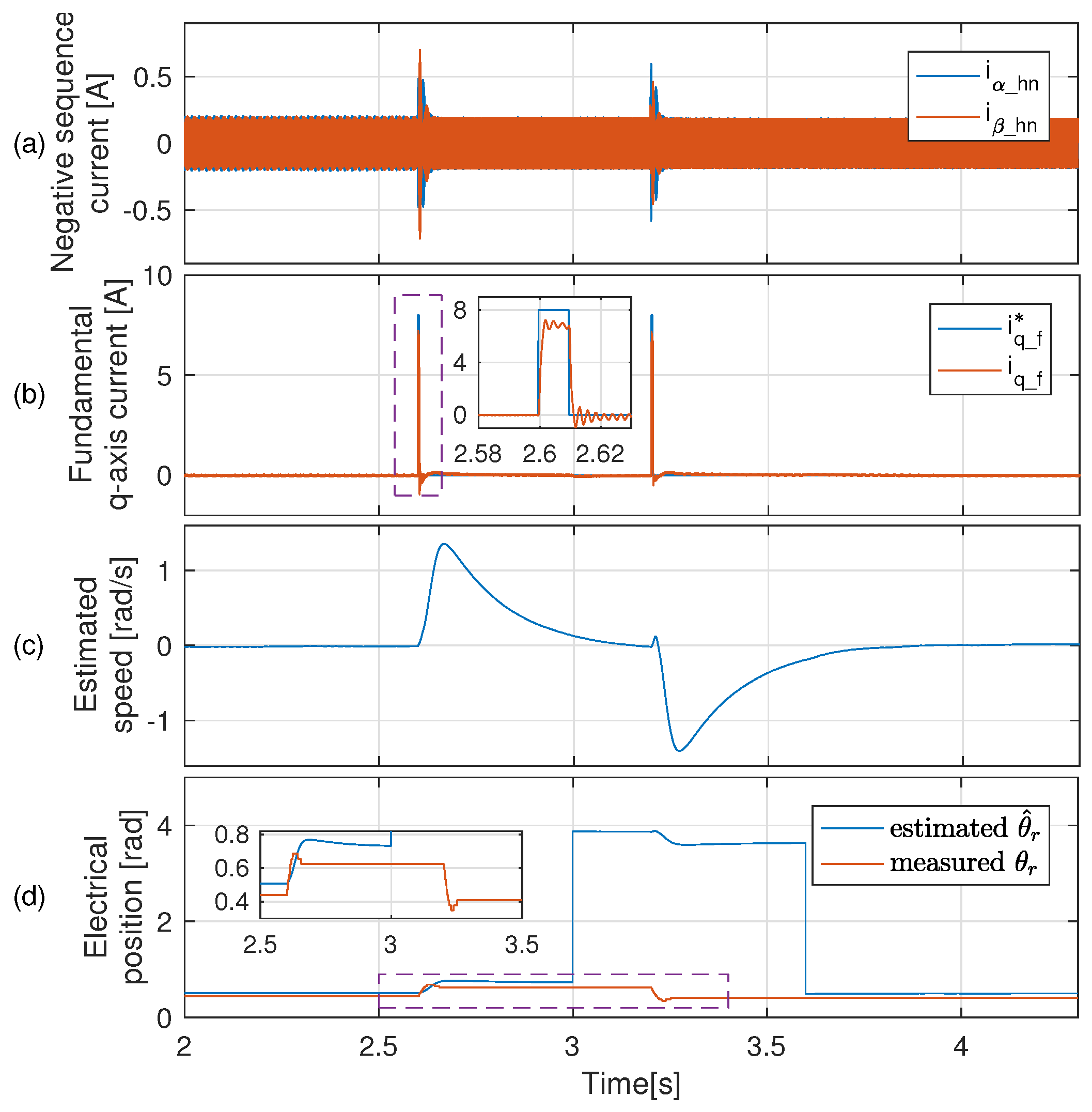
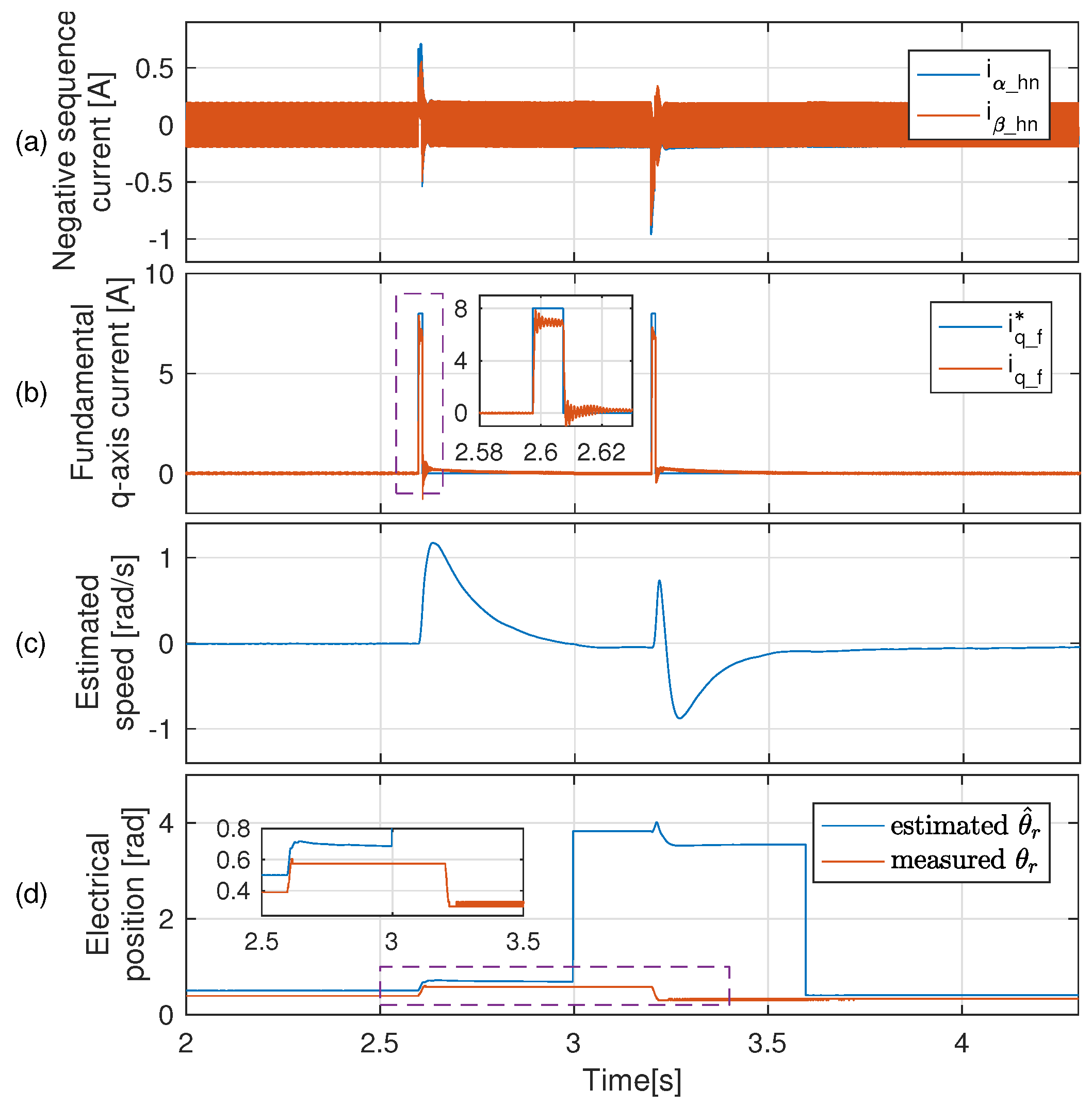
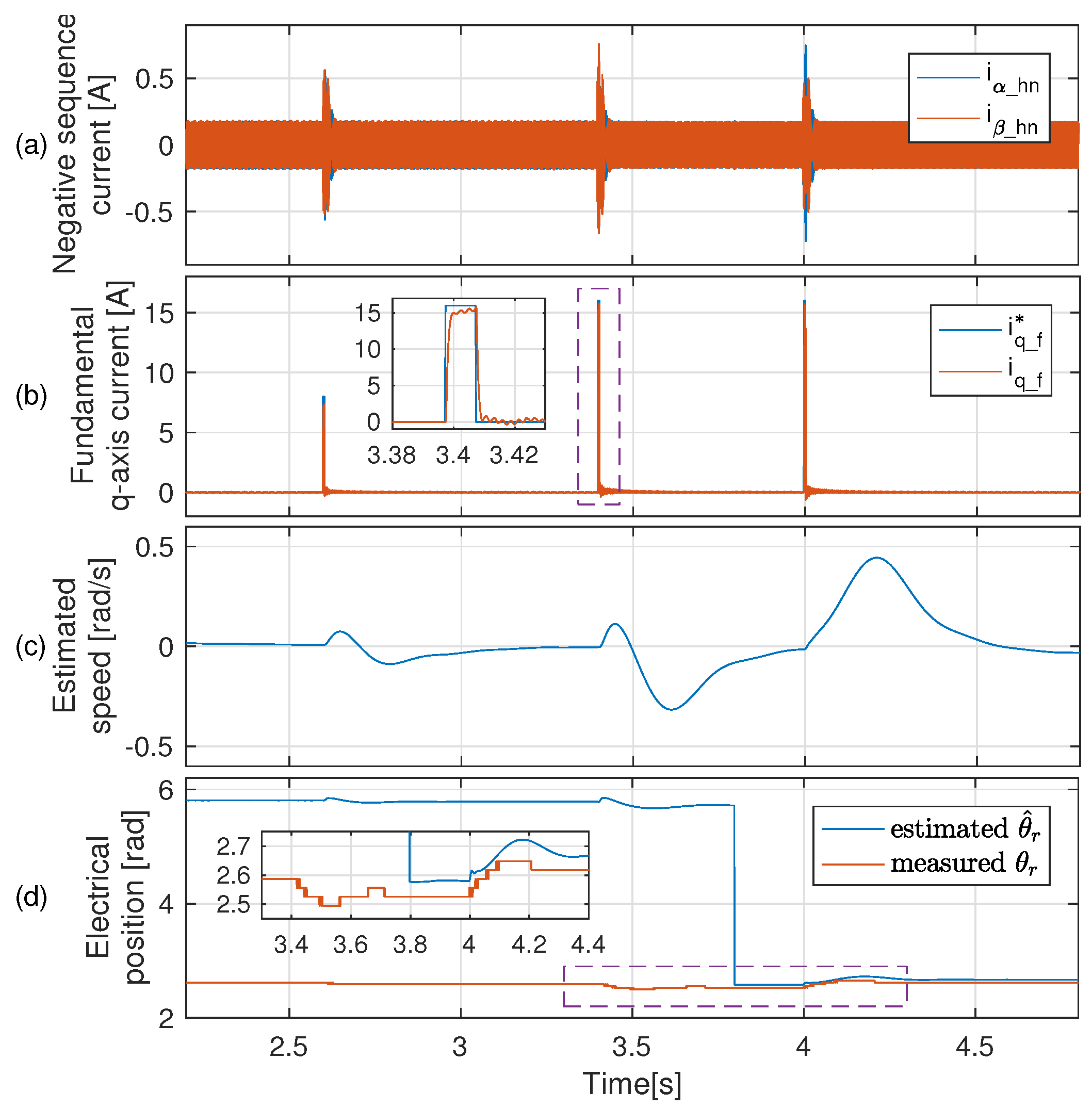
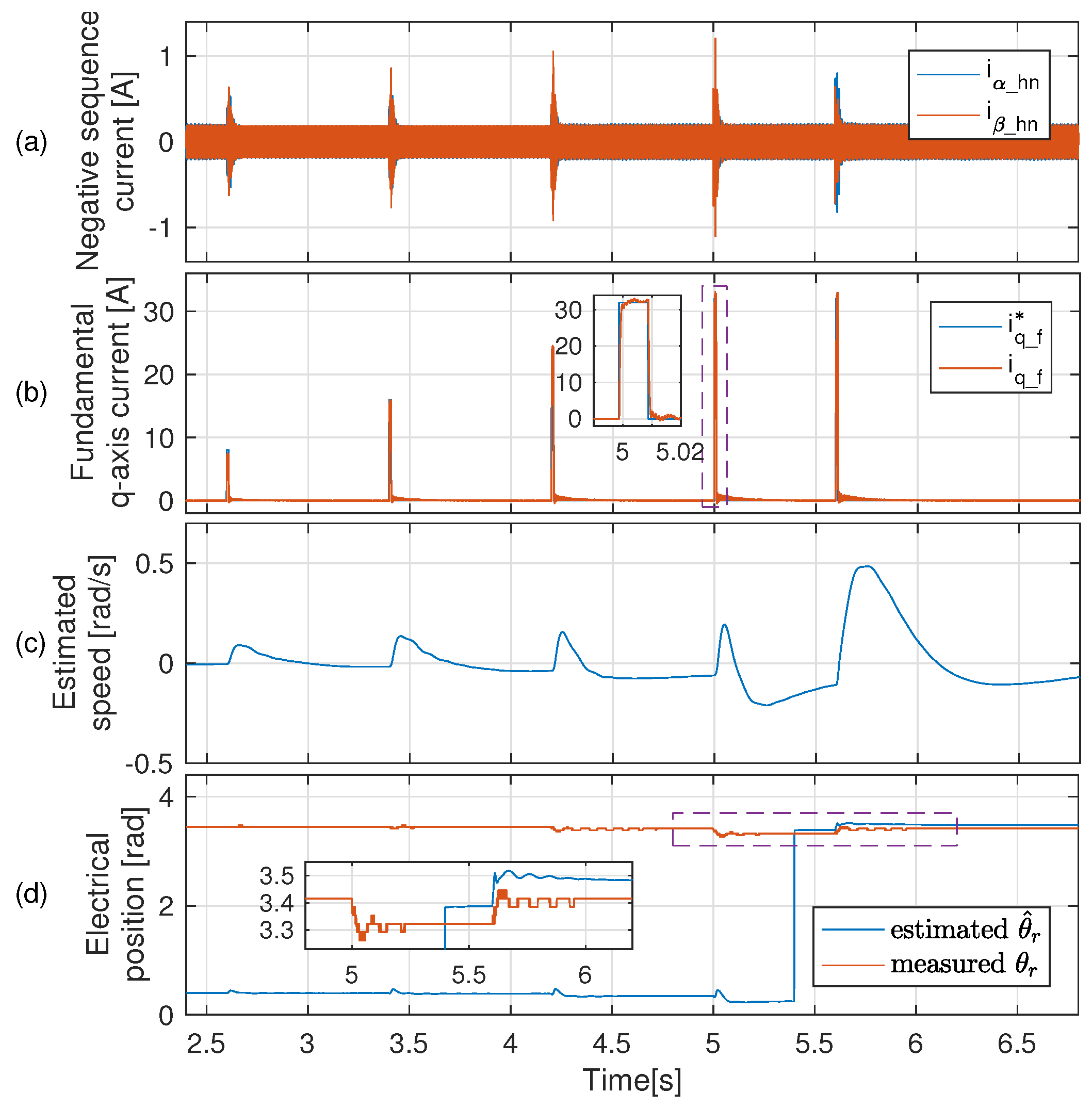
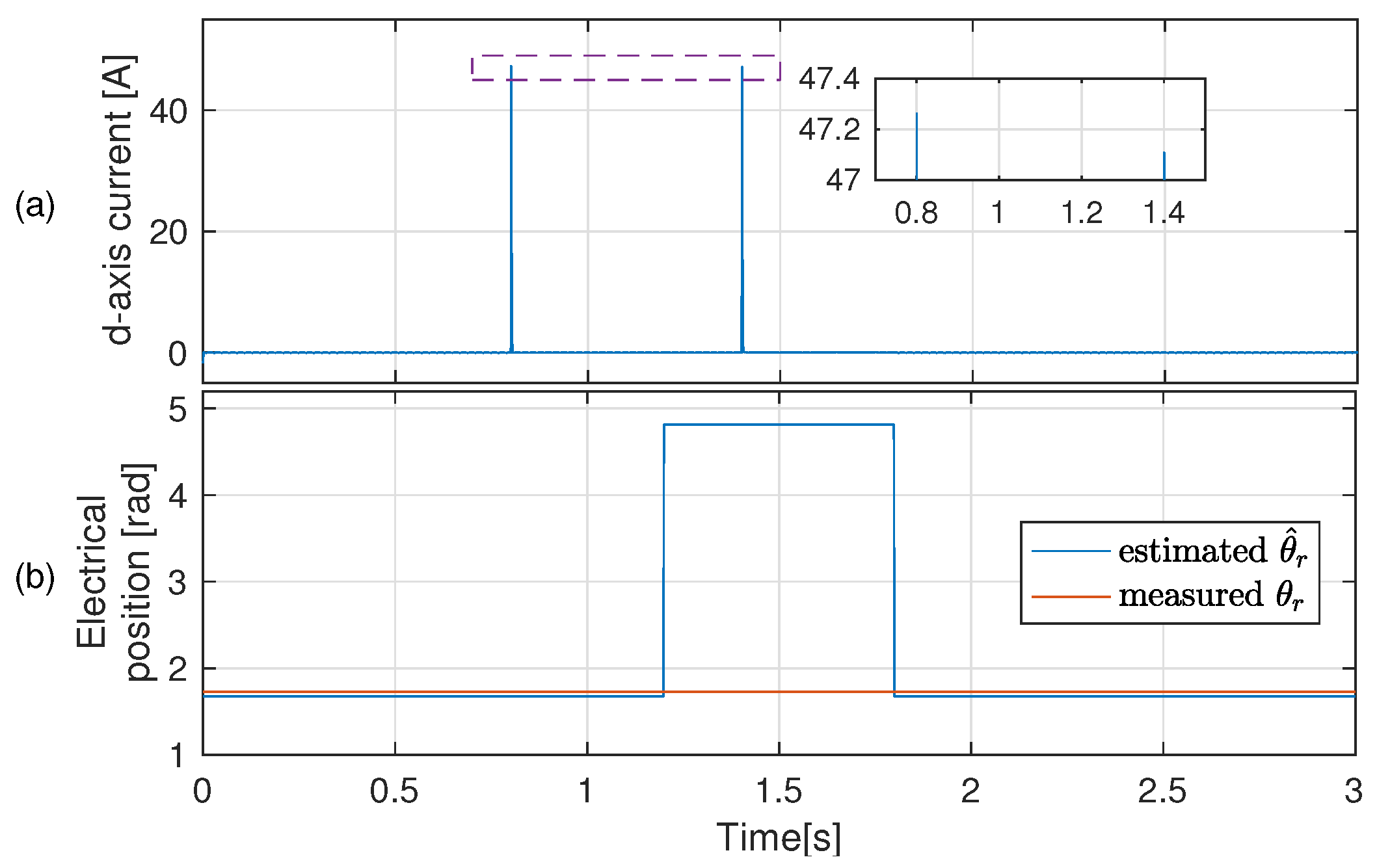

| Rated torque (N · m) | 2 |
| Rated current (Arms)/voltage (Vrms) | 40/13 |
| Number of pole pairs | 5 |
| -axis inductance (mH) | 0.065/0.09 |
| Resistance (m) | 36 |
| PM flux linkage (Vs) | 0.007 |
| Rated speed (rpm) | 2000 |
| Moment of inertia (g · m2) | 1.87 |
| Saturation-Based Method | Torque-Pulse-Based Method | ||||
|---|---|---|---|---|---|
| Estimated Position [rad] | Measured Position [rad] | Polarity Detection | Estimated Position [rad] | Measured Position [rad] | Polarity Detection |
| 3.307 | 0.250 | FALSE | 0.714 | 0.605 | TRUE |
| 3.598 | 0.520 | FALSE | 1.054 | 0.967 | TRUE |
| 4.550 | 1.544 | FALSE | 1.761 | 1.728 | TRUE |
| 1.629 | 1.753 | TRUE | 2.562 | 2.532 | TRUE |
| 1.892 | 2.023 | TRUE | 2.998 | 2.925 | TRUE |
| 3.357 | 3.440 | TRUE | 4.142 | 4.035 | TRUE |
| 3.624 | 3.680 | TRUE | 4.515 | 4.465 | TRUE |
| 4.785 | 4.913 | TRUE | 4.762 | 4.735 | TRUE |
| 1.920 | 5.183 | FALSE | 5.502 | 5.477 | TRUE |
| 6.171 | 6.232 | TRUE | 6.139 | 6.085 | TRUE |
Publisher’s Note: MDPI stays neutral with regard to jurisdictional claims in published maps and institutional affiliations. |
© 2022 by the authors. Licensee MDPI, Basel, Switzerland. This article is an open access article distributed under the terms and conditions of the Creative Commons Attribution (CC BY) license (https://creativecommons.org/licenses/by/4.0/).
Share and Cite
Yang, W.; Wang, Y.; Guo, H.; Sun, X.; Dajaku, G.; Riaz, S.; Zaman, H.; Gerling, D. Torque-Pulse-Based Initial Rotor Polarity Detection for IPMSM with Low Saturation Effect. Electronics 2022, 11, 4165. https://doi.org/10.3390/electronics11244165
Yang W, Wang Y, Guo H, Sun X, Dajaku G, Riaz S, Zaman H, Gerling D. Torque-Pulse-Based Initial Rotor Polarity Detection for IPMSM with Low Saturation Effect. Electronics. 2022; 11(24):4165. https://doi.org/10.3390/electronics11244165
Chicago/Turabian StyleYang, Weibin, Yuanlin Wang, Hao Guo, Xinxin Sun, Gurakuq Dajaku, Saleem Riaz, Haider Zaman, and Dieter Gerling. 2022. "Torque-Pulse-Based Initial Rotor Polarity Detection for IPMSM with Low Saturation Effect" Electronics 11, no. 24: 4165. https://doi.org/10.3390/electronics11244165






